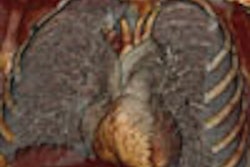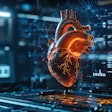Dear Cardiac Insider,
The dose-intensive nature of coronary CT angiography compels the search for better solutions. And so with today's Insider Exclusive we continue our series on dose-reduction techniques.
Researchers from GE Healthcare believe they've developed a method worth pursuing. In a "hot topic" presentation at the recent RSNA meeting, Jiang Hsieh, Ph.D., discussed the group's "step-and-shoot" image acquisition mode for coronary CTA on a 64-detector scanner.
Low-pitch helical acquisition used in most CT cardiac imaging ensures complete volume coverage and good phase registration over multiple cardiac cycles, Jiang said. The approach is effective, but at the price of a huge radiation dose and a lack of flexibility for dealing with irregular heart motion.
The proposed solution involves a table that remains stationary between cardiac cycles, moving into place just in time for the next acquisition. Advanced ECG gating assesses more than just the R-R peaks to time the acquisition. And, the researchers claim, a special reconstruction algorithm reduces exposure times due to tighter control of the x-ray exposure window. You'll find out everything the company was willing to tell us in today's Insider Exclusive story.
But that's not all the news in cardiac imaging. Among the stories you'll find in a quick scroll downward, 16-slice CT still seems to struggle in the differentiation of unstable noncalcified plaques and the less worrisome fibrous plaques. Some claim the problem amounts to a lack of software and detector rows, but a study from Germany offers a good look at the underlying difficulties.
Another German team quantified the relationship between heart rate and optimal reconstruction of CT images, and researchers from Berlin's Charité Hospital found that MRI and CT were roughly equivalent for assessing RV function.
In other news, investigators from North Carolina determined that subclinical cardiovascular disease may be more widespread among diabetic blacks than whites, but the opposite was true for coronary artery disease. Long-term anticoagulant use may increase coronary artery calcification. And while dark chocolate staves off atherosclerosis, chemotherapy appears to increase the risk of cardiomyopathy.
In ultrasound, echocardiography was found to accurately measure infarcts after reperfusion. And ECG could potentially be replaced by real-time ultrasound for triggering heart scans, according to a group from Michigan.
Last but not least, don't miss a key RSNA panel discussion on the state of the art of cardiac imaging, all in your Cardiac Imaging Digital Community.



















